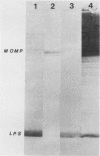Abstract
The enzyme-amplified immunoassay IDEIA (CellTech Diagnostics), which measures lipopolysaccharide antigen, and Chlamydiazyme (Abbott Laboratories, North Chicago, Ill.), which measures several antigenic components of Chlamydia trachomatis, were compared for specimens from urethral swabs from 235 men attending a clinic for sexually transmitted diseases (culture prevalence of 14.9%) and 458 endocervical swabs from women attending planned parenthood and obstetrics-gynecology clinics (culture prevalences of 5.9 and 7.7%, respectively). Compared with cell culture, the percent sensitivites, specificities, and positive and negative predictive values for IDEIA were 62.5, 99.5, 95.2, and 94.3%, respectively, for specimens from men and 96.3, 97.9, 74.3, and 99.8%, respectively, for specimens from women; results for Chlamydiazyme for specimens from men were 81.8, 99.5, 96.4, and 97.1%, respectively, and for specimens from women, results were 85.2, 99.3, 88.5, and 99.1%, respectively. Although the specificities of IDEIA and Chlamydiazyme were comparable, the sensitivity of IDEIA appeared higher for women (96.3%) than for men (67.5%), while the sensitivities of Chlamydiazyme were similar for men (81.8%) and women (85.2%). Western blot (immunoblot) analysis of the detector reagents from the two immunoassays indicated that the differences in performance observed for the two immunoassays may be due to measurement of different antigens.
Full text
PDF




Images in this article
Selected References
These references are in PubMed. This may not be the complete list of references from this article.
- Chernesky M. A., Mahony J. B., Castriciano S., Mores M., Stewart I. O., Landis S. J., Seidelman W., Sargeant E. J., Leman C. Detection of Chlamydia trachomatis antigens by enzyme immunoassay and immunofluorescence in genital specimens from symptomatic and asymptomatic men and women. J Infect Dis. 1986 Jul;154(1):141–148. doi: 10.1093/infdis/154.1.141. [DOI] [PubMed] [Google Scholar]
- Grillner L., Beckman S., Hammar H. Comparison of two enzyme immunoassays and an immunofluorescence test for detection of Chlamydia trachomatis. Eur J Clin Microbiol. 1986 Oct;5(5):559–562. doi: 10.1007/BF02017705. [DOI] [PubMed] [Google Scholar]
- Howard L. V., Coleman P. F., England B. J., Herrmann J. E. Evaluation of chlamydiazyme for the detection of genital infections caused by Chlamydia trachomatis. J Clin Microbiol. 1986 Feb;23(2):329–332. doi: 10.1128/jcm.23.2.329-332.1986. [DOI] [PMC free article] [PubMed] [Google Scholar]
- Mohanty K. C., O'Neill J. J., Hambling M. H. Comparison of enzyme immunoassays and cell culture for detecting Chlamydia trachomatis. Genitourin Med. 1986 Jun;62(3):175–176. doi: 10.1136/sti.62.3.175. [DOI] [PMC free article] [PubMed] [Google Scholar]
- Pugh S. F., Slack R. C., Caul E. O., Paul I. D., Appleton P. N., Gatley S. Enzyme amplified immunoassay: a novel technique applied to direct detection of Chlamydia trachomatis in clinical specimens. J Clin Pathol. 1985 Oct;38(10):1139–1141. doi: 10.1136/jcp.38.10.1139. [DOI] [PMC free article] [PubMed] [Google Scholar]
- Sulaiman M. Z., Foster J., Pugh S. F. Prevalence of Chlamydia trachomatis infection in homosexual men. Genitourin Med. 1987 Jun;63(3):179–181. doi: 10.1136/sti.63.3.179. [DOI] [PMC free article] [PubMed] [Google Scholar]
- Weismeier E., Bruckner D. A., Malotte C. K., Manduke L. Enzyme-linked immunoabsorbent assays in the detection of Chlamydia trachomatis: how valid are they? Diagn Microbiol Infect Dis. 1988 Apr;9(4):219–223. doi: 10.1016/0732-8893(88)90112-5. [DOI] [PubMed] [Google Scholar]



